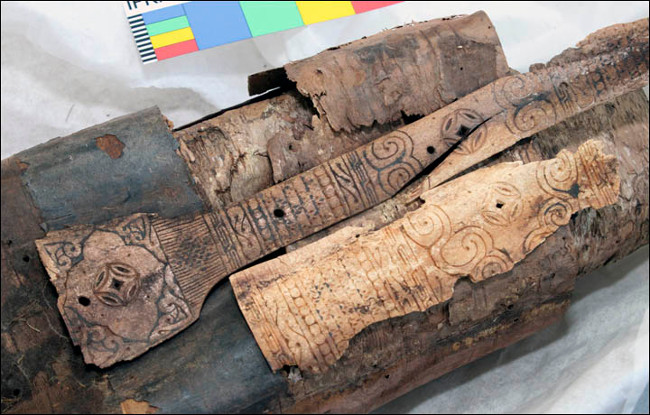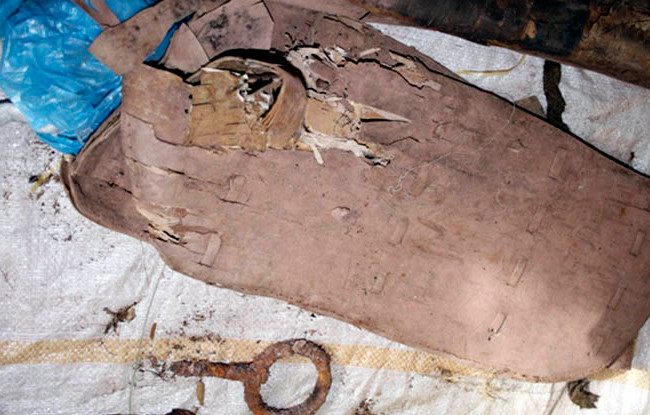Discovered the 15th - 16th century remains of archers in the Altai Republic landfill
A series of archaeological relics including specific weapons newly discovered in a landfill in the Altai Republic are evaluated in connection with a certain hero and archer character hundreds of years ago.
Two locals in the Altai Republic accidentally found in the landfill, near the village of Kokorya the skeleton of an adult man, located in a coffin made of birch bark.
In addition, a series of iron arrows, bows, intricate decorative items, tree roots and silk ribbons were also discovered.

According to carbon isotope analysis of artifacts and relics left at the excavation site, the results show that this character can be a warrior, famous for his archery skills, can live around 13th to 15th centuries, can imagine this character as legendary hero Robin Hood in England.

Scientific experts said that this archer could receive the love of the ancient inhabitants so they organized a thoughtful, complete burial service for this archer, like preparing everything for him when Enter another world. Including many artifacts, bows, arrows . were buried by ancient inhabitants.

Dr. Nikita Konstantinov, Head of the Museum of the State University of Gorno-Altaisk said: " At this time we have unearthed a birch wooden coffin, two pieces of decorative bone, arrows and leather saddles. , the ribbon, the silk . and the bones of this archer were shrouded in a carefully woven bandage " . Many experts believe that this archer may be Mongolian .

Archaeologists hope to be licensed by the local government to bring this character coffin to the Museum to conduct an examination, to study the character in more detail. As well as promising to discover many other relics on this landfill that we have not yet discovered.
The excavation time at this landfill has expired from November 1, 2016. And archaeologists are continuing to wait for permission. At the same time, winter is coming, scientists are also planning to preserve the archaeological sites excavated at the landfill.

Altai was an area that the Mongols first conquered in the 12th century. The area remained under Mongol rule until the 14th and 15th centuries.
You should read it
- Ancient burial tombs contain strange artifacts discovered in Izmir, Turkey
- Explore the world's deepest underwater caves in the Czech Republic
- Shocked with the screen of 'bullet' water knocked down prey 2m away from the archers
- Discover the world's most horrifying church in the Czech Republic
- Update of the Truth Arena 9.21 PBE update
- Not only does it hit the ground, lightning can also strike back from the ground to the sky
- Bitcoin Voted to Be Official Currency of Central African Republic
- Point Nemo, the most isolated place on the planet, the burial ground of the International Space Station at the end of the mission
May be interested
- Discover the world's most horrifying church in the Czech Republic
 join tipsmake.com to discover the world's most horrifying church in the czech republic!
join tipsmake.com to discover the world's most horrifying church in the czech republic! - Turkish monument 1,300 years old discovered in the Mongolian steppe
 archaeologists have discovered a unique monument, estimated from the eighth century, in the steppe of mongolia.
archaeologists have discovered a unique monument, estimated from the eighth century, in the steppe of mongolia. - Bitcoin Voted to Be Official Currency of Central African Republic
 the president of the central african republic believes that the adoption of cryptocurrencies in the country is a visionary action.
the president of the central african republic believes that the adoption of cryptocurrencies in the country is a visionary action. - Mycenean-era tombs with dozens of evidence were discovered in Salamina
 a mycenean tomb with ancient goods dating back to the 12-13th century bc was discovered in the center of the main town on salamina island, greece, discovered by chance in a home-link construction project. stay with central sewage network.
a mycenean tomb with ancient goods dating back to the 12-13th century bc was discovered in the center of the main town on salamina island, greece, discovered by chance in a home-link construction project. stay with central sewage network. - Video: Close-up of the terrifying power of the 'super rocket' that fired 100 arrows at once in the 15th century
 hwacha is a very famous korean archery machine. this article will show you the terrible power of hwacha.
hwacha is a very famous korean archery machine. this article will show you the terrible power of hwacha. - Found a way to detect HIV-infected T cells that are 'dormant', opening up hope for root
 recently, french scientists have discovered a biomarker that allows the identification of hiv-infected t cells in hibernation and among healthy cells that open up hope to cure the disease. century, aids.
recently, french scientists have discovered a biomarker that allows the identification of hiv-infected t cells in hibernation and among healthy cells that open up hope to cure the disease. century, aids. - Collective graves with 90 bones were discovered in central Madrid
 an ancient mass grave containing bones of at least 90 people was discovered at a location in central madrid.
an ancient mass grave containing bones of at least 90 people was discovered at a location in central madrid. - Unexpectedly unearthed 17 ancient tombs of the third century - IX at Vulci
 a series of 17 ancient tombs were found in the etruscan cemetery of vulci near viterbo, estimated to date from the third century - the 9th century bc.
a series of 17 ancient tombs were found in the etruscan cemetery of vulci near viterbo, estimated to date from the third century - the 9th century bc. - 'English Sweat' - A strange disease that mysteriously causes the deaths of thousands of people and has never been solved
 a strange disease broke out in england in the late 15th century, causing mysterious deaths for thousands of people. this strange disease is called the english sweat and is still a big medical question to this day.
a strange disease broke out in england in the late 15th century, causing mysterious deaths for thousands of people. this strange disease is called the english sweat and is still a big medical question to this day. - 'English Sweat' - A strange disease that mysteriously causes the deaths of thousands of people and has never been solved
 a strange disease broke out in england in the late 15th century, causing mysterious deaths for thousands of people. this strange disease is called the english sweat and is still a big medical question to this day.
a strange disease broke out in england in the late 15th century, causing mysterious deaths for thousands of people. this strange disease is called the english sweat and is still a big medical question to this day.










 Found the Roman ancient water tank under the warehouse in Turkey
Found the Roman ancient water tank under the warehouse in Turkey Discovered that the 2500-year-old skeleton of the Etruscan civilization suffers from strange chains and legs
Discovered that the 2500-year-old skeleton of the Etruscan civilization suffers from strange chains and legs Found ancient tombs containing more than 200 steles in southwest China
Found ancient tombs containing more than 200 steles in southwest China 2,000-year-old clay doll found in Osaka
2,000-year-old clay doll found in Osaka The 2,700-year-old goddess sculpture is found in the Aegean Sea
The 2,700-year-old goddess sculpture is found in the Aegean Sea Excavating an iron factory dating back to thousands of years in Cambodia
Excavating an iron factory dating back to thousands of years in Cambodia